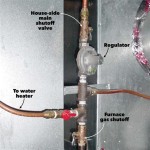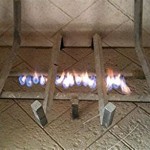Freestanding Fireplace Wood Burning Contemporary: A Modern Hearth
The freestanding, contemporary wood-burning fireplace represents a significant departure from traditional masonry fireplaces. Characterized by its minimalist aesthetic, ease of installation, and enhanced efficiency, it has become a popular choice for homeowners seeking both warmth and visual appeal. These fireplaces offer a flexible heating solution, combining functionality with a modern design sensibility that complements a variety of interior styles.
Unlike their built-in counterparts, freestanding fireplaces are not integrated into the existing structure of a building. This independence allows for placement in various locations within a room, offering design flexibility that permanently installed fireplaces lack. The inherent portability, while not intended for frequent movement, allows for strategic positioning to maximize heat distribution and visual impact. Furthermore, modern engineering and materials have significantly improved the safety and efficiency of contemporary wood-burning stoves, addressing concerns often associated with older models.
These fireplaces are not merely heating appliances; they are often considered focal points in a living space. The visible flame and crackling wood create an ambiance that evokes a sense of comfort and relaxation. The design variations are extensive, ranging from sleek, cylindrical models to those with geometric shapes and expansive glass viewing areas. The choice of materials, including steel, cast iron, and soapstone, further contributes to the diverse aesthetic options available to homeowners.
Key Features and Benefits of Contemporary Freestanding Wood Burning Fireplaces
Several features contribute to the allure of the contemporary freestanding wood-burning fireplace. These include improved combustion technology, a wider range of design choices, and a more sustainable approach to heating.
Enhanced Combustion Efficiency: Modern freestanding wood-burning fireplaces incorporate advanced combustion technologies designed to maximize heat output while minimizing emissions. Secondary combustion systems, for instance, re-burn gases that would otherwise be released into the atmosphere, resulting in cleaner burning and increased efficiency. This process not only reduces air pollution but also extracts more heat from the fuel, leading to lower wood consumption and reduced heating costs. Catalytic combustors, another common feature, further reduce emissions by facilitating the oxidation of unburned gases at lower temperatures.
The efficiency of a wood-burning fireplace is typically measured by its heat output and the amount of particulate matter (PM) released into the atmosphere. Contemporary models often boast efficiency ratings of 70% or higher, significantly exceeding the performance of older, less efficient fireplaces. Moreover, manufacturers are increasingly adhering to strict emission standards set by environmental agencies, ensuring that their products meet or exceed regulatory requirements. The Environmental Protection Agency (EPA) regulation, for instance, has been instrumental in driving innovation in wood-burning appliance design, leading to cleaner and more efficient heating solutions.
Design Flexibility and Aesthetic Appeal: One of the primary advantages of freestanding fireplaces is their design versatility. Available in a multitude of styles, sizes, and finishes, these fireplaces can be seamlessly integrated into a wide range of interior designs. From minimalist and modern to rustic and traditional, there is a model to suit virtually any aesthetic preference. The use of materials such as stainless steel, cast iron, and glass allows for the creation of visually striking pieces that serve as both a heating source and a design element.
The shape of the fireplace itself can vary significantly, ranging from classic rectangular designs to more contemporary cylindrical or elliptical forms. Some models feature large glass viewing areas, offering an unobstructed view of the flames and creating a captivating visual display. Others incorporate storage compartments for wood, adding a practical element to their design. The choice of finish can also have a significant impact on the overall aesthetic. Matte black finishes are popular for their understated elegance, while stainless steel finishes provide a more contemporary and industrial look. Porcelain enamel finishes offer a durable and colorful option, allowing homeowners to personalize their fireplace to match their existing decor.
Sustainable Heating Option: Wood, as a renewable resource, offers a more sustainable alternative to fossil fuels. When sourced responsibly from sustainably managed forests, wood-burning fireplaces can contribute to a lower carbon footprint. The carbon dioxide released during combustion is offset by the carbon dioxide absorbed by trees during their growth, creating a more balanced carbon cycle. However, it is crucial to ensure that the wood used is properly seasoned and burned efficiently to minimize emissions and maximize heat output.
The energy efficiency of modern wood-burning fireplaces also plays a role in their sustainability. By burning wood more completely and extracting more heat from each log, these fireplaces reduce the amount of wood required to heat a space. This not only lowers fuel costs but also minimizes the environmental impact associated with wood harvesting and transportation. Furthermore, the use of recycled materials in the construction of some fireplaces further enhances their sustainability credentials. Choosing a fireplace that is certified by an independent testing organization ensures that it meets stringent efficiency and emission standards.
Important Considerations for Installation and Operation
Proper installation and operation are crucial for ensuring the safety and efficiency of a freestanding wood-burning fireplace. Adherence to manufacturer's instructions and local building codes is essential for preventing hazards and maximizing performance.
Professional Installation is Recommended: While some homeowners may be tempted to install a freestanding fireplace themselves, professional installation is strongly recommended. A qualified installer will ensure that the fireplace is properly connected to the chimney or flue system, that it is safely positioned within the room, and that it meets all applicable building codes and regulations. Improper installation can lead to a variety of problems, including fire hazards, carbon monoxide poisoning, and inefficient heating.
The installation process typically involves connecting the fireplace to a chimney or flue system that vents combustion gases safely outside the building. The type of chimney or flue required will depend on the specific fireplace model and local building codes. In some cases, it may be necessary to install a new chimney or flue system to accommodate the fireplace. The installer will also ensure that the fireplace is properly sealed to prevent air leaks and that it is positioned a safe distance from combustible materials.
Selecting and Seasoning the Right Wood: The type of wood burned in a fireplace can have a significant impact on its efficiency and emissions. Hardwoods, such as oak, maple, and ash, are generally preferred for their higher heat output and longer burn times. Softwoods, such as pine and fir, burn more quickly and produce more smoke. It is essential to use seasoned wood, which has been allowed to dry for at least six months to a year. Seasoning reduces the moisture content of the wood, making it easier to ignite and burn completely. Burning green or unseasoned wood can lead to increased smoke production, creosote buildup in the chimney, and reduced heat output.
Proper wood storage is also important for maintaining its quality. Wood should be stored in a dry, well-ventilated area, away from direct contact with the ground. Covering the wood pile with a tarp can help to protect it from rain and snow. Regularly inspect the wood for signs of decay or insect infestation. Never burn treated wood, painted wood, or other materials that can release harmful chemicals into the air.
Regular Maintenance and Cleaning: Regular maintenance and cleaning are essential for ensuring the safe and efficient operation of a wood-burning fireplace. This includes cleaning the chimney or flue system at least once a year to remove creosote buildup. Creosote is a highly flammable substance that can accumulate in the chimney over time, increasing the risk of a chimney fire. A professional chimney sweep can safely and effectively remove creosote and inspect the chimney for any damage or deterioration.
In addition to chimney sweeping, it is important to regularly clean the inside of the fireplace to remove ash and soot. Ash can accumulate quickly, reducing the efficiency of the fireplace and potentially blocking air vents. Use a shovel and brush to remove ash from the firebox and dispose of it properly. Also, regularly inspect the door seals and glass panels for any signs of damage or wear. Replace any worn or damaged parts to ensure that the fireplace is operating safely and efficiently.
Contemporary Fireplace Materials and Design Considerations
The aesthetic of a contemporary freestanding wood-burning fireplace is heavily influenced by the materials used in its construction and the overall design principles applied.
Material Selection: The choice of materials significantly impacts the aesthetics, durability, and heat retention capabilities of the fireplace. Common materials include steel, cast iron, and soapstone, each offering unique properties.
Steel is often favored for its sleek, modern appearance and its ability to be shaped into a variety of forms. It heats up quickly but also cools down relatively quickly. Cast iron, on the other hand, is known for its excellent heat retention capabilities. It heats up more slowly than steel but retains heat for a longer period, providing a more consistent and even heat output. Soapstone is another popular choice for its exceptional heat retention properties and its natural, textured appearance. It is also relatively soft and easy to work with, allowing for the creation of intricate designs.
Design Integration: The fireplace's design should complement the overall aesthetic of the room. Considerations include scale, placement, and compatibility with existing furniture and décor.
The size of the fireplace should be proportional to the size of the room. A large fireplace in a small room can feel overwhelming, while a small fireplace in a large room may not provide adequate heat. The placement of the fireplace should also be carefully considered. It should be positioned in a location that maximizes heat distribution and provides a focal point for the room. The style of the fireplace should be compatible with the existing furniture and décor. A minimalist fireplace may be a good choice for a modern room, while a more ornate fireplace may be better suited for a traditional room.
Safety and Functionality: Safety features, such as spark screens and door locks, are crucial. Functionality includes ease of use for loading wood and cleaning ash.
Spark screens prevent embers from escaping the fireplace and causing a fire. Door locks prevent children and pets from accidentally opening the fireplace door. Easy access for loading wood and removing ash is essential for user convenience. The fireplace should be designed with a large enough firebox to accommodate a sufficient amount of wood and with a convenient ash removal system. Some fireplaces feature ash pans that can be easily removed and emptied, while others have built-in ash drawers.
Dru Fire
Dru Fire

15 Hanging And Freestanding Fireplaces To Keep You Warm This Winter Standing Fireplace

Hail The Queen Of Hygge Midcentury Modern Freestanding Fireplace Ashley Claire Real Estate Benchmark Realty

Freestanding Wood Stoves Friendly Fires

Contemporary Freestanding Fireplaces Modern Suspended Wood Heaters

Studio 2 Freestanding Wood Burning Stove Stovax Stoves

Suspended Fashion Indoor Freestanding Wood Burning Stove China Weather Resistant Fireplaces Made In Com
Dru Fire

Focus Fires And Fireplaces Wood Burning Gas Rangemoors Devon
Related Posts








